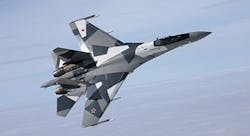Radioelectronic Technologies introduces precision navigation avionics at Paris Air Show
PARIS, 17 June 2013. Radioelectronic Technologies holding company in Moscow is introducing the SINS-SP2 avionics inertial navigation system this week at the Paris Air Show in Le Bourget, France. The SINS-SP2, which helps determine the location of an aircraft in the absence of satellite navigation and communications with ground-based services, is part of the Russian Sukhoi Su-35S multrole jet fighter.
The SINS-SP2 navigation system also will be installed on the fifth-generation Sukhoi T-50 jet fighter, which is scheduled to enter service with the Russian air force in 2016.
The SINS-SP2 system is designed and produced by the Radioelectronic Technologies holding company, part of Rostec State Corp. It is designed to determine the location of an object, as well as for integrated processing and reporting of navigation and flight information.
The system is capable of determining the position and motion parameters of the object on which it is installed in off-line mode in the absence of outside signals, Radioelectronic Technologies officials say. The architecture of the SINS-SP2 is based on three laser gyros and three quartz accelerometers.
The SINS-SP2 is able to determine the location of an aircraft with twice the precision of its previous version, company officials say. The equipment was developed and tested by the Moscow Institute of Electromechanics and Automation (MIEA). Production of the SINS-SP2 has been mastered at the Ramensky Instrument Engineering Plant, also part of Radioelectronic Technologies.
“The SINS-SP2 system is able to operate at both ultra-high and ultra-low temperatures -- from minus 60 degrees to plus 60 degrees, at an altitude of 25 kilometers,” says Alexey Kuznetsov, general director of MIEA.
The lifecycle of the SINS-SP2 is 10,000 hours, company officials say. Three modified systems are planned for installation on civilian aircraft, and two are planned for military aircraft. The SINS-SP2 can be used on aircraft, surface, and ground vehicles.
Radioelectronic Technologies holding company is Russia’s largest center for defence and civilian instrument engineering, and is engaged in electronic warfare, avionics, IFF systems, multi-purpose measuring equipment, electrical connectors and cable systems, as well as various household appliances and medical devices.
For more information contact the Rostec State Corp. online at www.rostec.ru, or the Paris Air Show at www.paris-air-show.com.
